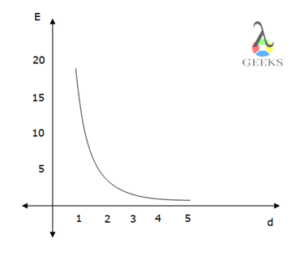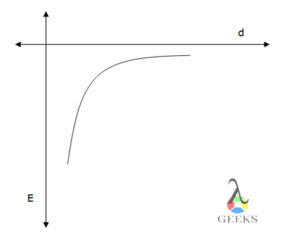In this article, we are going to discuss about the electrostatic force, and how it is dependent on the distance exhaustively.
A force between the two charged particles is known as the electrostatic force and the strength of the force relies upon the amount of charge held by the particle and the distance separating it from the other charged particle.
Electrostatic Force and Distance Graph
The electrostatic force between the two charges at rest is given by the relation:-
E=1/4 πɛ (q1q2/r2)
If the distance between the two charges increases, then the electrostatic force between the like charges will decrease, and that of between unlike charges the electrostatic force will increase on expanding the distance between the two charges.
If the two charges are the like charges then the product of the two charges will be positive and hence the electrostatic force will be positive.
As the distance between the two charges increases, the force will sharply fall initially and then gradually decrease further. Therefore, the above graph shows an exponential curve.
Read more on The Electric Field Between Two Plates: Formula, Magnitude, Direction, Imp FAQs.
Example: Consider two charges q1 and q2 having charges of 1C and 2C respectively. Find out the variation in the electrostatic force between these two charges is the distance between the two changes, and then plot the graph.
Given: q1 = 1C
q2 = 2C
At d=1cm
E1=1/4πɛ q1q2/r2
E1=9*109*{1C*2C/(1)2}
=9*109*2=18*109N
At d=2cm
E2=1/4πɛ(q1q2/r2)
E2=9*109*(1C*2C/(2)2)
E2=9*109*frac{2/4}
=9* 109*0.5=4.5*109 N
At d=3cm
E3= 1/4πɛ(q1q2/r2)
=9*109*(2/9)
=2* 109 N
At d=4cm
E4= 1/4πɛ(q1q2/r2)
E4=9*109*{1C*2C/(4)2}
=9*109*{2/16}
=1.125*109 N
At d=5cm
E5= 1/4πɛ(q1q2/r2)
E5=9*109*{1C* 2C/(5)2}
=9*109*{2/25}
=0.72*109N
Now, let us plot the graph for the above
We have,
| Distance (cm) | Electrostatic Force (× 109 N) |
| 1 | 18 |
| 2 | 4.5 |
| 3 | 2 |
| 4 | 1.125 |
| 5 | 0.72 |

Hence, it is clear that the electrostatic force will exponentially decrease with expanding distance if the two charges are like charged particles.
Further, let us see the relationship between the electrostatic force and the distance if the two charges are unlike charges. We are very well known that the two unlike charges shows the forces of attraction towards each other, and hence this force will increase if the distance between them increases and the graph will look like as shown below:-

The product of one negatively charged and one positively charged particle will give a product negative and hence the electrostatic force is negative. As the distance separating the two rises, the force of attraction between the two will increase per square distance.
Let us understand why the graph shows an exponential curve in this case too, by taking a simple example given below.
Example: Consider two charges q1 and q2 having charges of -1C and 2C respectively. Find the electrostatic force with the variable distance separating the two charged particles and then plot the graph for the same.
Given: q1 = -1C
q2 = 2C
At d=1cm
E5= 1/4πɛ(q1q2/r2)
E5=9*109*{-1C*2C/(1)2}
=9*109 * (-2)=-18*109N
At d=2cm
E2= 1/4πɛ(q1q2/r2)
E2=9*109*{-1C*2C/(2)2}
E2=9* 109*{-2/4}
=9*109(-0.5)=-4.5*109N
At d=3cm
E3= 1/4πɛ(q1q2/r2)
E3=9*109*{-1C*2C/(3)2}
=9*109*{-2/9}
=-2*109 N
At d=4cm
E4= 1/4πɛ(q1q2/r2)
E4=9* 109*{-1C*2C/(4)2}
=9*109*{-2/16}
=-1.125*109N
At d=5cm
E5= 1/4πɛ(q1q2/r2)
E5=9*109*{-1C*2C/(5)2}
=9*109*{-2/25}
=-0.72*109N
Now, let us plot the graph for the above
We have,
| Distance (cm) | Electrostatic Force (× 109 N) |
| 1 | -18 |
| 2 | -4.5 |
| 3 | -2 |
| 4 | -1.125 |
| 5 | -0.72 |

Hence, it is clear from the graph that as the distance between the two unlike charges increases, the electrostatic force increases along with the distance.
Read more on Is electrostatic force conservative: Exhaustive insights.
How are Electrostatic Force and Distance Related?
The electrostatic force is related to a distance by the relation E= 1/4πɛ(q1q2/r2)
The force of attraction between the two will increase if we separate the two charges apart and the force of repulsion will rise if the charges are placed near each other.
The electrostatic force primarily depends upon the charge of the particles depending upon which the force of attraction or repulsion comes into the picture. It completely relies upon the charge of the particle and the distance.
Read more on Net Electrostatic Force: How to Find, Problems and FAQs.
Problem: Three charged particles are separated by a distance having different charges as shown in the below figure. Calculate the electrostatic force on charge Q1.

The electrostatic force between charge Q1 and Q2 is
E1=1/4πɛ0(q1q2/r2)
=9*109*{1C*3C/(2)2}
=9*109*{3/4}
=6.75*109N
The electrostatic force between charge Q1 and Q3 is
E2=1/4πɛ0(q1q2/r2)
=9*109*{1C*(-2)/(3)2}
=9*109* {(-2)/9}
=-2*109N
Hence the net force acting on the point
F=E1+ E2
=(6.75-2)*109
=4.75*109N
The net force on the point charge Q1 is 4.75 × 109 N.
Read more on Electric Force Examples: Exhaustive Examples.
Does Electrostatic Force Increase with Distance?
The electrostatic force increases with the distance if the two electric charges kept are unlike charges.
As the electrostatic force is inversely related to the distance separating the two electric charges, the force of attraction will increase when this distance will lengthen to a greater and greater extent.
This is not the case between the repulsive charges. If the distance increases separating the two electric charges, this force of repulsion between the two charges will decrease. So, in the case of like charges, the electrostatic force will decrease as the gap between the two electric charges will reduce.
Read more on Force On Moving Charge In Electric Field: Several Approaches and Problem Examples.
How does Distance Increase Force?
The force is increased if the distance between the like charges is reduced and between unlike charges is extended.
The force of attraction between the two unlike charges increases if the distance separating the two charges increases, and the repulsive electrostatic force will be more when the two like charges will be very close to each other, that is if the distance between the two charges will be minimum.
How does Electrostatic Force Work?
A force of attraction or repulsion between the two charges is called the electrostatic force.
The electrostatic force directly relies upon the charge that a particle carries depending upon the number of protons and electrons constituted by the particle.
Depending upon a charge there is a force of attraction or repulsion between the two charges separated by some distance. The unlike charges show the electrostatic force of attraction as the electron carriers in the particle attract towards the particle that has maximum carriers of the protons which are positively charged because the electrons can fill the vacant spaces in the positively charged particle.
Well, the like charges will apply a force on each other to push away contrarily. This is because two positively charged particles will have the maximum number of protons and hence will move away if there is no availability of electrons. The same is the case when two charges are negatively charged and they have more number of electrons, the particle will no longer take more number of electrons hence does not show attraction towards each other.
Read more on Electrostatics.
Frequently Asked Questions
What is the electrostatic potential?
The potential of the electric charges to do the work or to get the work done defines the electric potential of that charge.
The electrostatic potential is the energy required to bring a charged particle from an infinite position to a finite distance by the application of the electrostatic force between the point charge and that particle at an infinite distance.
How electric potential is different from electric force?
The electric potential is the energy of one particle whereas the electric force is a force imposed due to two or more charged particles.
The energy required for a charged particle to do the work is called the electric potential, and on contrary, the force acquired between the two charged particles is the electric force.
What is electrostatics?
The term electrostatics deal with the electric charge carriers, and their characteristics.
There is always a force of attraction and repulsion depending upon the number of charge carriers in the particle which is known as electrostatic force.
Also Read:
- Conservative force examples
- Magnetic field and force
- Is magnetic field and magnetic force same
- Boiling point and molecular forces
- Gravitational force of moon
- Central force examples
- Is gravitational force a central force
- Nuclear force examples
- Is net force a vector
- Is support force a contact force
Hi, I’m Akshita Mapari. I have done M.Sc. in Physics. I have worked on projects like Numerical modeling of winds and waves during cyclone, Physics of toys and mechanized thrill machines in amusement park based on Classical Mechanics. I have pursued a course on Arduino and have accomplished some mini projects on Arduino UNO. I always like to explore new zones in the field of science. I personally believe that learning is more enthusiastic when learnt with creativity. Apart from this, I like to read, travel, strumming on guitar, identifying rocks and strata, photography and playing chess.